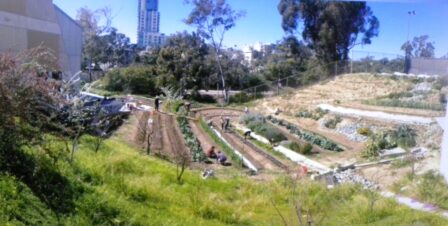Successful Gardening with Less Water
Damian Valdez, head urban farmer at San Diego City College, educated the Mission Hills Garden Club about how the Sustainable Urban Agriculture Program, a part of the Life Sciences Department, successfully cuts back on water while still growing lush, healthy plants which are both edible and ornamental. The program teaches students garden design and how to grow plants; they also learn the agriculture business. Some of the produce they harvest is sold at the school’s farmer’s market, and some goes into the school cafeteria. According to Valdez, training students to become urban farmers is growing increasingly important. From this program they can begin to work in agriculture immediately, or they can earn an Associate’s degree. Some students continue their education at a four year college or university since the AA degree is limited to a maximum two years’ lower division college credit.
Valdez had interesting statistics to support the need for his program. With over fifty percent of the world population living in cities, fifteen per cent of the world’s food is actually grown in cities. The United States farmer’s average age is 59. By 2030 two thirds of the world’s population will be city dwellers because agricultural farmers are aging and/or leaving their farms. If we want to be able to provide healthy, nutritional food for the world, we will need more urban farmers. This is food security.
To accomplish this goal, in 2008 San Diego City College (SDCC) began reducing its water consumption by fifty percent. The students created a production model to show how to increase growing and food production in urban environments. At SDCC the largest area under cultivation is the greenhouse which has over 20 fruit trees. In addition, the lawns gave way to gardens where students learn how to produce a profitable way to feed people. The orchard site at SDCC is the largest area under cultivation with over twenty fruit trees growing. Unused spaces can be used to encourage greater biodiversity of beneficial pollinators without having a major impact on water consumption.
Espaliered sites work for gardens as well as lawns. No land is wasted at SDCC. Even a site contaminated with lead and thus unsuitable for growing food became a flower garden. Drought tolerant plants did not force the students to grow nothing but cacti and succulents. Now this garden is full of drought tolerant plants and flowers such as salvias and sunflowers. Another useful and drought tolerant plant is milkweed, essential for monarch butterflies to breed. Your nursery can give you other suggestions. You too can have a garden which attracts other beneficial pollinators whose work encourages greater biodiversity without having a major impact of water consumption.
One of the ways to conserve water — even drought tolerant plants do need some water – is with a slow drip system. It emits water slowly enough for it the plant to absorb it without runoff and evaporation. To ensure water’s arrival to each root zone, emitters should be placed to irrigate each plant’s roots. If you are planting directly into the bed, your seeds should be sowed right next to the drip tape. For perennial herbs and various drought tolerant beneficial seed mixes there are micro spray emitters. For established perennials and fruit trees, flag and button emitters work well.
Valdez told us they use berms as another means of conserving water. Berms and rain barrels catch rain water and feed it to the plants. Swales are ditches. Man-made swales are ditches that follow the contours of the land and have flat bottoms to hold water instead of having it run off. It slowly seeps into the landscape. These are a few of the ways to use the terrain to conserve water and human energy.
Currently SDCC is experimenting with another water-saving method, using ollas and raised beds to see how well various agricultural crops will do. An olla is a container that has small holes in it. One way of creating one is using a plastic bottle with holes punched in its sides placed with its opening just above the soil. It stores water and allows it to slowly leach into the soil. This only works on plants with established roots, however. Valdez says you can also make your own ollas by gluing unfired ceramic pots together with silicone based adhesive. The water penetrates the unglazed ceramic.
Valdez pointed out that we are learning valuable lessons from the drought. We must use water with respect; we need urban farming, especially as the Central Valley becomes drier. We will be forced to diversify our food supply if we want food security.
The next meeting of the Mission Hills Garden Club takes place from 6 to 8 p.m., September 23, 2015 at the church located at 4070 Jackdaw.
Category: Local News








